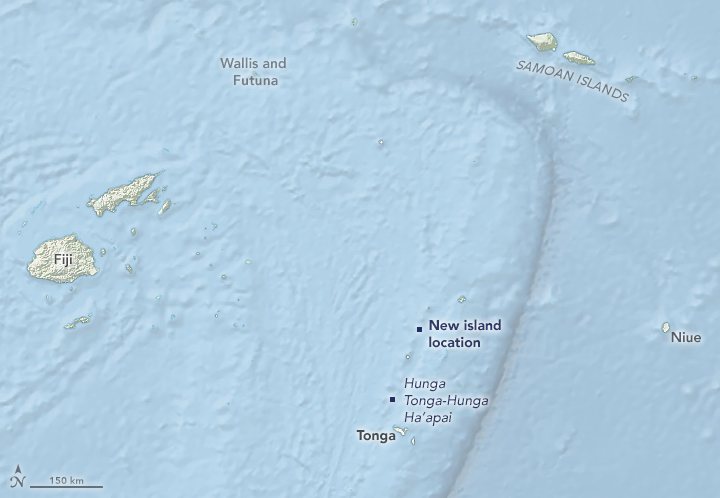

Today’s Image of the Day builds on this story from November 20, 2019.
At the same time that scientists were standing on and studying the five-year-old Hunga Tonga-Hunga Ha‘apai island, another island-building event was unfolding just 150 kilometers (90 miles) to the north-northeast in the Southwest Pacific Ocean. An undersea eruption at Lateiki Island in late October 2019 has brought new life to an older island in the Tonga chain.
The birth of the island is visible in these images, acquired with the Operational Land Imager (OLI) on Landsat 8. The top image shows the eruption on its third day, October 16, 2019. The false-color image combines shortwave infrared, near infrared, and blue light (bands 7-5-2) to help distinguish the hot spots associated with the eruption (red). Scientists say the emissions were dominated by steam and volcanic gases.
When the plume cleared on November 1, satellites started getting clear views of the new land that had emerged. Landsat 8 acquired the second, natural-color image of Lateiki Island on November 17. Note that water around the island was still discolored from the eruption’s emissions. The new island measures about 400 meters (1300 feet) long and 100 meters (300 feet) wide.

Lateiki Island, also known as Metis Shoal, is just the tip of a large undersea volcano (seamount) in an extremely active part of the Tonga Archipelago. (Scientists put it in the top ten most active volcanic areas on Earth). Prior to 2019, an eruption in 1995 also produced an island. That island saw considerable erosion and was ultimately destroyed by the 2019 event, which built a new island in its place. Earlier eruptions followed a similar cycle; islands that emerged in 1781, 1854, 1876, 1967, 1979, are all reported to have submerged within months, having succumbed to the erosive lashing of the sea.
Lateiki’s history of erosion is not unique. Thousands of islands across Earth’s oceans are in a phase of decay. “We rarely see them as ‘newborns’ to watch how they evolve to become what they are,” said NASA scientist Jim Garvin. “Here in Tonga we can now watch and measure how they form and evolve in their childhood years, and compare them with others across the oceans to build better models for their evolutionary stages.”
Previous eruptions at Lateiki have not been thoroughly documented by satellites, according to Garvin. He noted that this year, scientists are paying close attention to the region with Landsat-8, ESA’s Sentinel-2, and other satellites. “We’re excited because we have looked at this tiny island for the last 20 years,” he said. “Now the old one is gone and we get to watch the new one develop.”
They are particularly interested in seeing how the development and composition of Lateiki compares with Hunga Tonga-Hunga Ha‘apai (HTHH)—an island that appears to be stabilizing instead of eroding, and hence surviving. HTHH grew from an eruption that went through a series of phases over the course of six weeks, including an ash dominated surtseyan phase that built a 120-meter-tall cone, followed by explosive phases that spread material around the vent to grow the 180-hectare (0.69-square-mile) island. In contrast, the volcanic activity at Lateiki was less explosive, with lava piling up around the vent to form the relatively small 3-4 hectare islet.
“Why they are different is unknown,” Garvin said. “We need to find out so we can predict lifespans of other islands as ‘dip-sticks’ for global environmental change in a time of sea level rise on Earth.”
NASA Earth Observatory images by Lauren Dauphin, using Landsat data from the U.S. Geological Survey and using topographic data from the Shuttle Radar Topography Mission (SRTM). Story by Kathryn Hansen, with information courtesy of Taaniela Kula and the government of the Kingdom of Tonga.